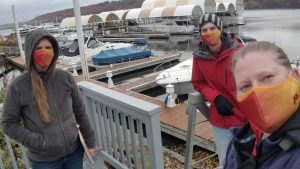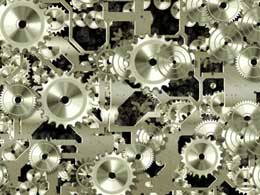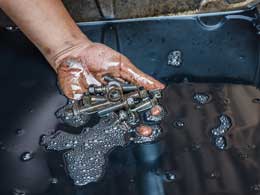October 2020: Assisting MN Businesses Every Day
Inside the Newsletter:
Clean Water | Technical Assistance | Metal Fabrication | Cleaner Parts | Funding Opportunities
Clean Water – Strategies for Wastewater Nutrient Reduction
Nitrogen and phosphorus are essential nutrients in soil to boost agricultural yields, however, in water, the story is quite different. In high levels, these nutrients are harmful pollutants that cause excessive growth of algae leading to depressed oxygen levels and an inability for the waterbody to sustain aquatic life. MnTAP is conducting a project with the help of student researchers and an elite team of wastewater experts from the Minnesota Pollution Control Agency (MPCA), Minnesota Rural Water Association (MRWA), and the City of St. Cloud Nutrient, Energy and Water Recovery Facility to identify low cost options to optimize nutrient removal from wastewater treatment facilities and wastewater ponds (WWTFs) prior to discharge to surface waters.
MnTAP is taking a dual approach to providing technical assistance to reduce nutrient load in treatment facility effluent and improve water quality.
- First, the project team identified WWTFs that discharge high nutrient loads. These facilities were contacted about the program and site staff volunteered for assessments and student research projects to identify operating strategies that increase nutrient removal efficiency.
- Second, businesses with potentially high discharge of nutrients upstream of these WWTFs were identified. These businesses were offered confidential, no cost process assessments to focus on wastewater load reduction opportunities.
This dual approach has demonstrated the effectiveness of using both nutrient source reduction strategies for facilities upstream of wastewater operations and improved treatment strategies at the WWTFs to protect Minnesota water quality.
To date, MnTAP has conducted assessments and developed recommendations for 10 mechanical wastewater treatment plants and 13 pond systems with average daily influent flow between 5 and 0.5 million gallons per day (MGD). MnTAP’s combined recommendations for wastewater treatment plant optimization could provide annual savings of nearly 615,000 lbs pf nitrogen and 120,000 lbs of phosphorus in the effluent streams when implemented. If these nutrient savings are realized, this would eliminate 1,157,200 lb/yr of ferric chloride needed to treat this nutrient load. An additional 4,178,100 kWh of electric energy could be saved annually from reduced blower operation. Combined, sites could realize up to $707,600 per year in energy and chemical savings.
Relationships developed with city employees while assessing the WWTFs facilitated conversations with industries in town that may have opportunity to reduce nutrient effluent discharged to the municipalities. These facilities have a strong incentive to work with the wastewater plant to reduce overall nutrient loading and help the WWTFs operate more efficiently. This project can serve as a model for municipalities to help WWTFs meet effluent permit requirements and protect Minnesota waterbodies with modest investments. The approach is a powerful combination of pollution prevention by reducing load generated at the source, and optimizing treatment of the waste that does end up down the drain.
Examples from this project can be found on the MnTAP website for the 2020 MnTAP Intern Program.
For more information on this project contact:
- Daniel Chang – Associate Engineer
612 – 624 – 0808 | dwchang@umn.edu - Josh Kirk – Associate Engineer
612 – 624 – 1300 | kirkx115@umn.edu
Funding for this project comes from the Legislative-Citizen Commission on Minnesota Resources (LCCMR).
Technical Assistance – Options for your Business
Business might not look like it did at the beginning of the year, but MnTAP is here to help make the new normal, more efficient. Staff at MnTAP are ready to help your business meet financial goals by reducing water, energy, waste generation and operating costs. By analyzing processes in your facility during a no-cost, confidential site visit or remotely through video meetings, MnTAP staff will look for opportunities for savings that could help both the facility environmental performance and the bottom line.
How to connect with MnTAP
Telephone or e-mail assistance from MnTAP can help your organization:
- Get quick answers to waste and energy-related questions
- Discover opportunities for rebates, low interest loans, and grants
- Start more in-depth pollution prevention and energy efficiency initiatives
If you have a question, contact one of our industry specialists directly. If you are not sure who to contact, e-mail MnTAP.
Telephone
Give us a call! Both our main and staff telephone lines are available and voice messages are responded to as soon as possible.
612-624-1300 or 800-247-0015
Website
The MnTAP website can be a useful source of information for your organization. The website has many guide-lines, resources, worksheets, webinars, and case-studies that may give you ideas or guide you to you what are looking for.
Read Publications covering topics such as: pollution prevention and energy efficiency, Solutions, IMPACT, and past newsletters.
View webinars covering topics such as: Compressed Air, Degreasing, Food Processing, Paint, and Plastics.
Call or email today and you can start improving the environmental performance and the bottom line of your facility!
Focus on Metal Fabrication
This Fall MnTAP is launching a pollution prevention (P2) effort to create meaningful technical assistance resources tailored for the metal fabrication industry. Fabricated metal processes generate various waste streams; oily wastes from machining operations, heavy metal bearing streams from surface treatment and plating operations, hazardous and regulated solvents, alkaline and acid solutions from metal cleaning, chloride discharges from softened water and other sources. In addition to materials, energy efficiency and water conservation opportunities may be available to help businesses improve their overall sustainability performance and reduce operating costs.
The goal of the project is to really listen to the concerns of this sector through a series of informational interviews with practitioners and vendors, collaborate with stakeholders to determine the best pollution prevention and operational efficiency options, and share new and established standards for best practices to improve industry performance.
The project offers onsite technical assistance to provide facility level pollution prevention assessments, identifying the most pressing needs at each site. MnTAP will follow up with participating companies to facilitate implementation of identified opportunities and document impacts to share with industry members through case studies and publications.
The project plan includes four primary activities.
- Listen to Minnesota industry practitioners and stakeholder to understand environmental and sustainability priorities through a series of informational interviews.
- Summarize and share key findings along with source reduction resources and technical assistance activities to assist businesses in meeting identified material and sustainability targets.
- Provide technical site assessments creating business specific options for safer materials use, waste reduction, energy efficiency and water conservation.
- Support implementation activities so businesses can capture environmental and economic benefits.
If you are interested in learning more about this project contact:
Daniel Chang – Associate Engineer
612 – 624 – 0808| dwchang@umn.edu
Funding for this project comes from the Minnesota Pollution Control Agency’s pollution prevention grant through the U.S. EPA.
Cleaner Parts Cleaning – Technologies to Consider
Are you still using brake cleaner for degreasing? Tired of the expense and the waste? Looking for something that can perform better that is not harmful to your health? The following are two parts cleaning strategies to consider.
Bioremediating cleaning systems, such as the CRC Smartwasher® with OzzyJuice®, use an aqueous cleaner to remove grease, oil, and contaminants from parts, then use microbes to eat those contaminants and break them down into carbon dioxide and water. This results in a long lasting cleaning solution and minimal waste to dispose. OzzyJuice® is an aqueous, non-flammable, pH neutral cleaner that can be used to clean metal and non-metal parts. It has been awarded the EPA Safer Choice Label which recognizes products formulated with safer chemical ingredients without sacrificing performance. The heated Smartwasher® keeps the solution at the right temperature for effective cleaning and healthy microbes, and filters out dirt, grit, and other particulates. It is offered as a stationary unit or as a mobile unit that can be rolled into position for brake cleaning. If you would like to try this system in your facility, CRC offers a 30-day free trial. Other bioremdiating systems are available from Oil Eater, Graymills, and Bio-Circle
Ultrasonic washers have come down in price in recent years, and are more affordable than ever. These benchtop units take up less space than other aqueous systems and are ideal for those hard to clean tricky geometries, like carburetors. Ultrasonic washers use sound waves to create tiny bubbles that do the scrubbing for you and can work with a wide range of cleaners. There are many different sizes available with capacities just right for whatever job you are doing. For smaller, specific cleaning jobs, add the cleaner and part to a smaller jar, and put the jar in the ultrasonic water bath, then save the cleaner for next time.
Switching to these alternative methods may call for a change in how work flows in a facility. The benefits are a cleaner clean with less volatile organic compounds (VOCs) released to the air. Proper disposal of aqueous fluids can be found on the MPCA website in document w-hw4-44. In most cases, the water portion of the waste can be evaporated off, greatly reducing the volume to be disposed.
For more information contact:
Daniel Chang – Associate Engineer
612 – 624 – 0808| dwchang@umn.edu
Funding Opportunities
Business Pollution Program Offers Increased Support for Businesses
As many businesses have seen reduced business during the COVID-19 pandemic and are facing economic hardship, the Business Pollution Prevention Program is now offering increased support to dry cleaning, auto body, and painting businesses in Ramsey County to adapt to safer and more efficient technology. The program offers financial support for up to 75% of project costs, up to $50,000, for businesses to upgrade their equipment to reduce pollution and improve the health of workers, communities, and the environment. For more information, contact Christina Vang at cvang@environmental-initiative.org.
MPCA Grants for Emissions Reductions from Refrigerants
The MPCA has grant opportunities for projects that reduce emissions from refrigerants used in cold-transport vehicles and in grocery, convenience store, and food storage facilities in Minnesota. The grants target greenhouse gas refrigerants that contribute to climate change.
Ozone-damaging refrigerants such as chlorofluorocarbons and hydrochlorofluorocarbons, which were once common, have been replaced by high global warming potential (HGWP) refrigerants that, while sparing the ozone layer, have a greater capacity to warm the atmosphere than carbon dioxide. The MPCA encourages the use of alternative refrigerants and practices that reduce refrigerant use.
Eligible projects must reduce or prevent refrigerant emissions that contribute to climate change. This includes replacing or retrofitting equipment to enable use of HGWP-refrigerant alternatives, switching to a less harmful refrigerant, or installing leak monitoring devices on refrigeration equipment. The maximum award is $40,000, and the grant recipient must match at least 25% of the total project cost.
Apply now! Deadline is December 11, 2020
To learn more about this grant opportunity and download the application forms, visit the MPCA web site. Email grants@pca.state.mn.us with questions.
MPCA Loans to help to reduce TCE
The MPCA has made up to $250,000 for small businesses to switch from using TCE to a safer alternative. The Small Business Environmental Improvement Loans are available at zero-percent interest for equipment purchases and installation associated with a switch from TCE. Eligible projects will reduce air emissions through switching from the use of TCE to an alternative demonstrated to be less toxic.
See the MPCA website to Learn more



